 |
|
|
BiblePlaces Newsletter
Vol 3, #2 - March
23, 2004
The most frequent question I get concerns locating electronic
maps for teaching. With the availability of the photographs
of biblical sites in the Pictorial Library, the major missing
component for presentations is high-quality maps which can quickly and
easily be used in PowerPoint. I have been working on a reply to this question for more than a year, and plan to dedicate an
entire newsletter to the topic (next month?). In the meantime,
if you have any suggestions in this regard, I'd appreciate hearing
from you
([email protected]).
This month's newsletter has a few items of news and some
recommended links to free, high-resolution satellite photographs from
NASA. What you won't get anywhere else though are
free, high-resolution photographs of the Judean
Wilderness. I have had some great days exploring in various
sections of the wilderness in the last few months and I've selected
some of the best photographs for this newsletter.
And for those of you waiting for the new edition of the
Pictorial Library of Bible Lands, scheduled for release by Kregel
Publications in November.... keep waiting. I've received a
set from the publisher but they've not quite made it to the
distribution channels yet.
Todd Bolen
Editor, BiblePlaces.com
Assoc. Professor, The Master's College
Israel
Bible Extension (IBEX), Judean
Hills, Israel
News
Evidence from Exile Returnees Discovered
Rare evidence from the late 6th century B.C. was recently
uncovered in a cave at En Gedi in the excavations of Hanan Eshel. In
general, evidence in Israel from the Persian period is limited, making
remarkable these discoveries of glass and gold beads, bronze mirrors, a
necklace, and a Babylonian seal impression with the figure of a priest
worshipping the moon god. These objects apparently belonged to a group
of Jewish people who had been in exile in Babylon and were allowed to return
following the decree of Cyrus (Ezra 1). For more information, see this
Jerusalem Post article (or if that link doesn't work,
here).
Wealthy Villa Unearthed in Netanya
A two-room villa from the Byzantine period was uncovered
recently in Netanya during construction of a highway offramp. The rooms
contain elaborate mosaics and a lead water pipe. Discussions are ongoing
as to how to preserve the building. For more information, see this
Haaretz article
(or
here).Beth Shean Antiquities' Warehouse
Destroyed
A medieval building that housed thousands of antiquities from the
Beth Shean excavations was destroyed in a fire set by arsonists earlier
this month. The most valuable finds from the excavations are
housed elsewhere, but this building included ancient potsherds, marble,
and glassware artifacts. For more information, see this article in
the
Jerusalem Post.
Controversial Matters
The Passion
Two scholars, Dr. Andrea Berlin and Dr. Jodi Magness, give an
evaluation of the accuracy of "The Passion of Jesus Christ" from a
historical and archaeological perspective. The current interest in the
movie provides a good opportunity for learning the background of
crucifixion. Interesting reading, even if we have some disagreements.
The article is available in pdf format
here.
Crucifixion
BAR magazine recently reported that Joe Zias claims to have seen the
"James Ossuary" in Jerusalem before the "brother of Jesus" inscription
was added. Whether or not that can be confirmed, we have recently
learned of the website of this
scholar, which includes a few of his articles for downloading. The one
on crucifixion is especially helpful.
The Jehoash Inscription
It has not been my practice to address the same controversial issues
in each newsletter, but since many have concluded it is a patent fraud,
I thought this recent
article to be of interest. Several scholars have issued a call for a new
examination of the artifact. Prof. Cohen of Ben-Gurion University says
this:
"There is nothing philological in the inscription that attests to its
being a forgery. I can categorically refute all the evidence that my
colleagues have brought up in concluding that it is a forgery. I can
explain everything written there from a linguistic point of view as
suited to the biblical period, to the period of Jehoash, the ninth
century BCE. And I am not the only philologist who thinks so." See
the full article in Haaretz
here. Another interesting scholarly note in this regard from Victor Sasson
can be read
here.
Featured Resource:
Free Satellite PhotographsDid you know that
some of the most unique photographs of the Middle East are available for
free in high-resolution without copyright restrictions? NASA has
more than 6,000 photographs on their
Visible Earth website,
including 128 of the Middle East. These include satellite images
in high to super-high resolution (up to 6400x5000 pixels!), including
tif and png formats (up to 20MB). Unless noted, these photographs are
not copyrighted. Here are a few of my favorites, with direct links
to the high-resolution photographs.
|
|
Free
High-Resolution Photos One of my
favorite places to explore is the Judean Wilderness. I have had many
opportunities to do so in the last few months and I have chosen some of my
favorite photographs from those trips for this newsletter.
As always, these photographs are recent, unpublished,
and linked to high-resolution photographs which may be used freely for
personal and educational purposes. |
|
|
|
|
|
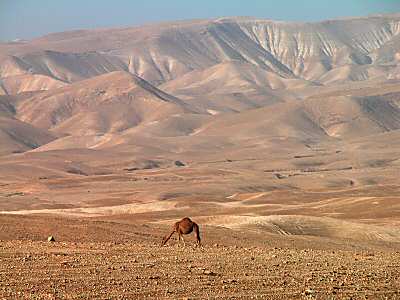
Click picture for higher-resolution version. |
|
Dry and Thirsty Land
The Judean Wilderness is the stretch of land between
the Judean Hill Country and the Dead Sea. Because it is on the
leeward side of the mountain range, it receives little rainfall and is
better for shepherds moving with their flocks than for farmers. In
ancient times, this region was uninhabited and ideal for seeking
seclusion or refuge. Today the area is largely empty except for
the occasional military base or camel herd. |
|
Nahal Tseelim
Because of the steep descent of the Judean Wilderness to the
Dead Sea (1300 feet below sea level), rapid run-off has created deep
canyons draining to the Dead Sea. These canyons (Hebrew: nahal;
Arabic: wadi) are dry except for a brief time during and shortly
after a rainfall. A few miles north of Masada is Nahal Tseelim,
where some of the scrolls from the time of Bar Kochba were discovered (135
A.D.). |
|
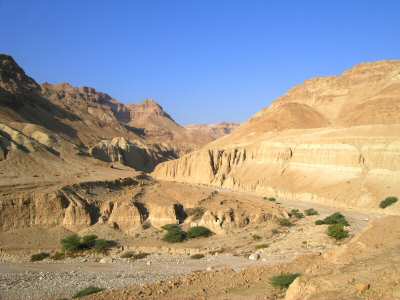
Click picture
for higher-resolution version. |
|
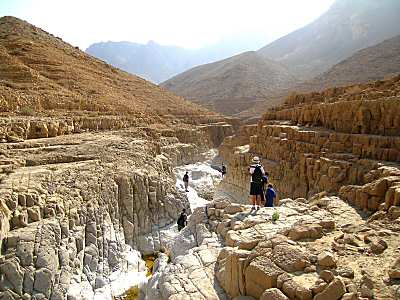
Click picture
for higher-resolution version. |
|
Nahal Mishmar
About midway between Masada and En Gedi is Nahal
Mishmar. Like the Tseelim, Arugot, and Darga, this nahal runs
east-west and is a barrier to north-south travel because of its
significant size. In a survey of the Judean Desert in the early
1960s, a cave in Nahal Mishmar was discovered with a large hoard of
copper objects from the Chalcolithic period (4th millennium B.C.).
These artifacts from the "Cave of the Treasure" are known for their
beauty and perfect preservation. |
|
Ein Perat Springs
are rare in the Judean Wilderness, and they were valuable to
ancient travelers, as is evidenced by the remains that can often be found
in their vicinity. Ein Perat is about 5 miles east of Jerusalem,
and not far from the prophet Jeremiah's hometown of Anathoth. It is
probable that the prophet hid his loincloth here and not at the Euphrates
River (both places are spelled prt in Hebrew; cf. Jer 13). In
Herod's day, an aqueduct brought water from this spring to his palace in
Jericho. |
|
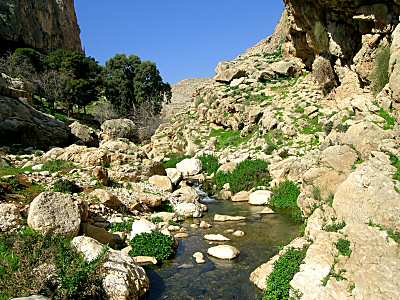
Click picture
for higher-resolution version. |
|
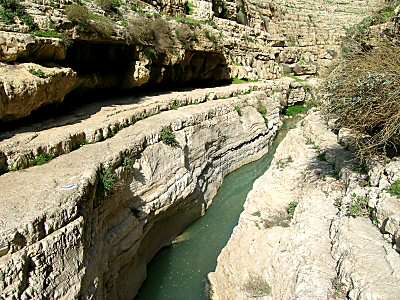
Click picture for
higher-resolution version.
|
|
Streams in the Wilderness
It is not common to see this much water flowing through the Wadi Qilt, but after
heavy rains, the normally dry canyon flows with water. Such a picture is
given in a description of the blessing of the land in Isaiah 35: "Water
will gush forth in the wilderness and streams in the desert.
The burning sand will become a pool, the thirsty ground
bubbling springs" (NIV). |
|
Spring of the Young Goats
En Gedi means "spring of
the young goats." This photograph shows a mother and her kid drinking
from a spring at En Gedi. These goats, known as ibex, are dependent
upon water and thus live near a dependable supply. Ibex have
apparently lived in the area of En Gedi for thousands of years, as
attested by the name of the spring and by depictions of ibex on objects
found in the Cave of the Treasure in the nearby Nahal Mishmar.
|
|
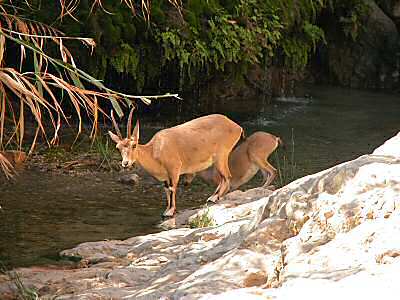
Click picture
for higher-resolution version. |
|
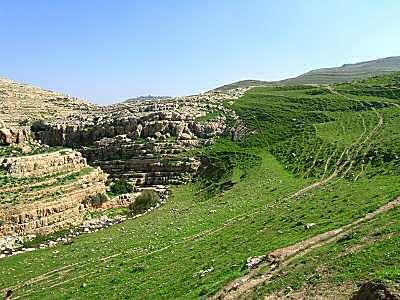
Click picture for
higher-resolution version.
|
|
For a Season
This is not Scotland, honest! For a short period of time after the winter
rains, short grasses grow on the slopes of the wilderness. Though it may
appear that this is the natural and permanent state of things, in a
few weeks, the sun and hot east wind causes the grass to shrivel and die.
Isaiah compared men to this grass:
?All men are like grass, and all their glory is like the
flowers of the field. The grass withers and the
flowers fall, because the breath of the LORD blows on them. Surely the people
are grass? (40:6-7). |
|
YOU CAN HELP
You can help us and others by
forwarding this link
To subscribe or unsubscribe to this newsletter,
click here.
|
|

